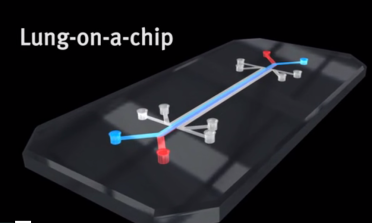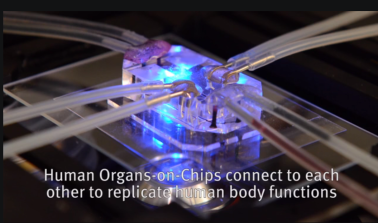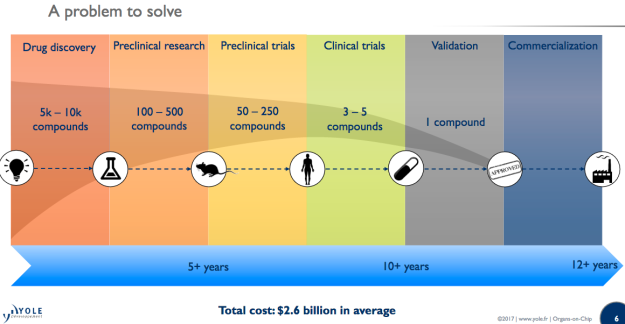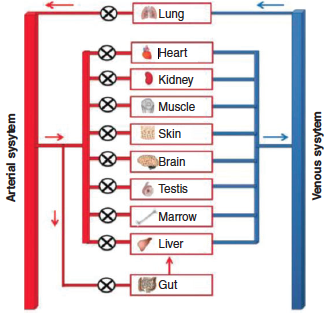After looking at the animal model market, I wondered about industry predictions for new developments in biomedical research that are human-relevant. Perhaps the field known as organs-on-chips holds the greatest promise for physiologically relevant, precisely controlled, and scalable engineered systems for use in the drug development process.
According to the Wyss Institute for Biologically Inspired Engineering at Harvard University, human organs-on-chips are microchips lined by living human cells that can be used in drug development, disease modelling and personalised medicine.
This is what they look like:

Source: Wyss Institute

Source: Wyss Institute
The development and testing of new drugs takes many years and is expensive. Very expensive. The cost of developing a new prescription drug is now around $2.6 billion. Traditionally, animals such as mice and dogs have been used in the development of drugs. But around 90% of new drugs that have been found to be safe and effective in animals fail in clinical trials with humans.

Source: Yole Développement
To understand this high attrition rate between drug development and approvals, it is imperative to consider the drawbacks of the current methods of preclinical testing. Traditional 2D cellculture models can be effective in providing a broad indication of
compound efficacy and toxicity; however, they fail to represent cell function and physiology accurately because these cultures are monolayers as opposed to the 3D structures found in an intact organ and hence important tissue–tissue interactions are absent. Furthermore, upon the ingestion of a drug, it undergoes important transformations that allow it to be absorbed, distributed, metabolized and excreted (ADME). Examining these processes provides important information on the pharmacokinetics (PK) of the drug including dose, concentration and toxicity profiles. These parameters are traditionally tested in animals such as rodents and dogs along with a determination of safety and efficacy. However, a simple extrapolation of the PK and toxicity profiles from animals to humans is inaccurate owing to the vast differences in the genomes between the two species, as in the case of TGN1412. The development of assays that can better predict the safety, pharmacology and toxicity of a drug in humans is of paramount importance. Organs-on-chips is one such system that has the potential to reduce the dependence on animal testing and provide a more accurate readout of the safety and efficacy profile of a drug compared with conventional methods.
Source: Balijepalli, A., & Sivaramakrishan, V. (2017). Organs-on-chips: research and commercial perspectives. Drug Discovery Today, 22(2), 397-403.
In 2010, Donald Ingber at the Wyss Institute developed the first organ-on-a-chip, a lung-on-a-chip. Since then, academic institutions and private companies – sometimes working in partnership – have added miniature models of, for example, the liver, kidney, heart, bone marrow, cornea, brain, spleen and the human gut.
A multidisciplinary team at the Wyss Institute have also developed a chip that smokes cigarettes like a human. So there is no excuse to force mice to inhale cigarette smoke, as researchers at the Hunter Medical Research Institute and The University of Newcastle have done.
An organ-on-a-chip is about the size of a human thumb and “made from a flexible, translucent polymer. Microfluidic tubes, each less than a millimeter in diameter and lined with human cells taken from the organ of interest, run in complex patterns within the chip. When nutrients, blood and test-compounds such as experimental drugs are pumped through the tubes, the cells replicate some of the key functions of a living organ“.
Organs-on-chips can be used to study many biomedical phenomena. Apart from drug development and toxicity testing, other possible uses include, for example, personalised medicine (where stems cells derived from individual patients could be used to identify which therapies might be likely to succeed) or testing responses to biological and chemical weapons.
As an alternative to conventional cell culture and animal models, human organs-on-chips could transform many areas of basic research and drug development. They could be applied to research on molecular mechanisms of organ development and disease, on organ-organ coupling and on the interactions of the body with stimuli such as drugs, environmental agents, consumer products and medical devices. Fundamental questions that might be addressed include how microenvironmental cues regulate cell differentiation, tissue development and disease progression; how tissues heal and regenerate (e.g., mechanisms of control of angiogenic sprouting and epithelial sheet migration); and how different types of immune cells and cytokines contribute to toxicity, inflammation, infection and multi-organ failure. When combined with patient-specific primary or iPS cells, or with gene editing technologies (e.g., CRISPR) to introduce disease-causing mutations, this technology could be used to develop personalized models of health and disease.
Source: Bhatia, S. N., & Ingber, D. E. (2014). Microfluidic organs-on-chips. Nature Biotechnology, 32(8), 760-772.
A recent article in the journal Drug Discovery Today provided the following examples of investment in organ-on-chip developments:
- The Wyss Institute has received a $5.6 million grant from the United States Food and Drug Administration (FDA) to use its organs-on-chips technology to test human physiological responses to radiation, and to evaluate drugs designed to counter those effects.
- The US National Institutes of Health (NIH) runs the ‘Tissue Chip for Drug Screening’ program which funds research related to microchip devices.
- PETA awarded small grants to students to help them develop placentas-on-a-chip.
- The European Union has awarded € 1.4 million to five organisations in four countries to jointly pursue research into body-on-a-chip devices.
- Mimetas, a company that specialises in organs-on-chips, has received US$ 1.6 million funding for development of an organ-on-a-chip model for neurotoxicity, sponsored by GlaxoSmithKline, BASF, Sanofi and AbbVie.
- Johnson & Johnson is collaborating with Emulate for the use of lung, thrombosis and liver chip models in drug testing. (Emulate is a startup company that grew out of the work at the Wyss Institute)
- TissUse is another company that develops multi-organ-technology. TissUse’s technology “makes it possible to replicate up to four human organs, scaled down 100,000 times, from cell tissue on a microscope slide“.
- Hesperos has developed 2-organ systems with liver and muscle as well as cardiac and liver. The company also has working prototypes of functional 4-organ systems.
- CN Bio Innovations also works on a human body-on-a-chip. The company sells a liver-on-a-chip, with prices for the LiverChip starting at about $22,000. Using this technology is faster and far more cost-effective than animal research.
These are only a few examples of work on organs-on-chips. Worldwide, it is considered a multi-million, or even billion dollar market. For example, Yole Développement estimates that “the market could grow at a compound annual growth rate from 2017-2022 of 38-57% to reach $60M-$117M in 2022.” Another company, Accuracy Research, expects the organs-on-chips market to grow around 69.4% over the next decade to reach approximately $6.13 billion by 2025.
Large pharmaceutical and cosmetics companies are expected to start using organs-on-chips. Some companies have already partnerships with organs-on-chips developers, such as L’Oréal, Pfizer, AstraZeneca, Roche and Sanofi.
Ethical concerns are also at the heart of this new market: more than one hundred million animals are used in laboratory experiments worldwide every year, and could be replaced by pieces of microfluidic technology. Source: Yole Développement
Where does Australia sit in this market?
Some projects at the Australian Institute for Bioengineering and Nanotechnology, University of Queensland involve “the development of tumour-on-a-chip, organs-on-a-chip for rapid preclinical evaluation of potential nanomaterials for targeted therapeutics”. At the International Conference on Biomedical Engineering in December 2016, Professor Justin Cooper-White from this institute presented a keynote address on “Human kidney organogenesis from pluripotent stem cells on a chip”. There were other presentation on organs-on-chips, but none from Australia.
Two PhD Scholarships Bioengineering 3D in vitro model systems were recently advertised by Swinburne University of Technology.
A few academics with affiliations to Australian universities have published articles on organs-on-chips. However, it is unclear whether they are involved in the development of this technology. I could locate three articles in peer-reviewed journals on the topic:
- Nauman Khalid, a Postdoctoral Research Fellow at Deakin University has co-authored two articles, titled “Recent lab-on-chip developments for novel drug discovery” and “Industrial lab-on-a-chip: design, applications and scale-up for drug discovery and delivery“. I could not locate any information on the Deakin University website that links him to current work on organs-on-chips.
- One of the 14 authors of “Screening out irrelevant cell-based models of disease” lists Queensland University of Technology as an affiliation. In the article, the authors discuss new opportunities for exploiting the latest advances in cell-based assay technologies, of which organs-on-chips are one.
- Researchers from RMIT had a review of “Successes and future outlook for microfluidics-based cardiovascular drug discovery” published.
Where is the investment in organs-on-chips?
The published outcomes of the 2016 NHMRC Grant Application Round include two projects that involve work on organs-on-chips. The project descriptions are as follows:
Neurodegenerative diseases such as dementia and motor neuron disease are a major health burden for Australia and new approaches to treatment are urgently required. Essential trace elements such as copper, zinc and iron show major changes in neurodegneration, however, we do not understand how this drives disease processes. This proposal will develop an innovative 3D ‘brain on a chip’ cell model to probe the role of trace elements in brain pathology and identify exciting new treatments options.
and
New human cell culture models of Alzheimer’s disease are urgently needed to help translate drugs into successful patient outcomes. In this proposal we will develop an Alzheimer’s disease brain-on-a-chip that contains the major human brain cell types and neuropathological features of the Alzheimer’s. We will demonstrate the applicability of the model for identifying new Alzheimer’s disease drugs and diagnostics and show that the model can be readily adopted by Australian Alzheimer’s researchers.
Total grant funding for all 1,056 funded projects adds up to $828 million. The extent of the funding for the two organs-on-chips projects is not obvious from the published data, nor at which university, research institute or hospital the work will be undertaken.
I could not find information about investment on this technology by private companies.

Body-on-a-chip. Source: Khalid, Kobayashi & Nakajima, 2017.
Perhaps there is more work on organs-on-chips occurring in Australia, but I couldn’t find relevant information (I searched Google and PubMed). By and large, in Australia researchers continue to use archaic methods that hurt animals, are costly and ineffective. Despite the development of more human-relevant methods, the use of animals for research and education purposes is not decreasing in Australia.
The latest available statistics have just been published by Humane Research Australia. They “show that approximately 10.27 million animals were used in research and teaching in Australia in 2015, although this high number is largely due to NSW counting 4,123,049 native animals in environmental studies which involved observation only.” This compares to approximately 7 million animals in 2014.
Here we have a potentially multi-billion dollar market, and Australia is fiddling at the edges.